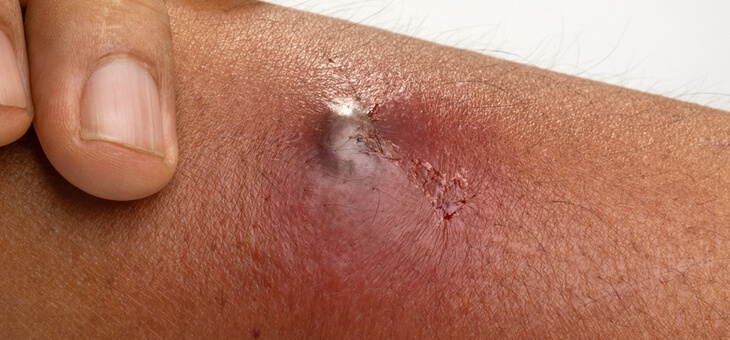They often start out looking and feeling like a particularly nasty pimple, but the swelling and tenderness soon indicate that you’re dealing with an abscess.
Here’s how to recognise the signs and what to do about them.
An abscess is a tender mass under the skin, usually accompanied by a discoloured patch of skin ranging from pink to deep red. Abscesses are primarily caused by infections and are often easy to differentiate from regular acne by their sheer size and the level of pain they cause.
They are full of pus, bacteria and dead skin, signs that your immune system is trying to fight off the infection.
An abscess can form on any part of your body, but the most common sites are in your armpits, areas around your genitals, the base of your spine, and around your groin. Inflammation around a hair follicle can also lead to the formation of an abscess, which is known as a boil.
Read: Embarrassing personal questions answered
Squeezing them is torture, but ignoring an abscess can be even worse. Unlike other infections, antibiotics alone do not usually fix the problem. An abscess needs to open and drain to improve. Sometimes this will happen on its own but often it will need to be opened using a warm compress or by a doctor making an incision.
Is that an abscess?
An abscess, which starts off as a small red lump, can easily be mistaken for more common acne. But unlike a pimple, it won’t clear with time. The mass progresses to a painful, compressible mass that is red, warm to touch, and tender.
As some abscesses progress, they may form a large white head, exposing the material inside. It can be tempting to try to pop the abscess yourself, but this will be extremely painful and often won’t open the head.
They can sometimes spontaneously open, but generally without care the infection can spread to the tissues under the skin and even into the bloodstream. If the infection spreads into deeper tissue, you may develop a fever and begin to feel ill. You may also experience swollen lymph nodes.
Read: How to look after your skin microbiome
What can I do about them?
Experts recommend using heat to relieve symptoms, if you have an abscess that hasn’t been drained. Put a towel over the abscess and use a heat pack or heating pad for 20 to 30 minutes. Remove the heat source if your skin gets red.
If this doesn’t cause the abscess to rupture, it may be time to seek professional medical help. Larger or deeper abscesses will need to be drained by a doctor. You may also need to take antibiotics, depending on the severity of your infection.
If the abscess is in your mouth, put a cold compress on the outside of your cheek to control the swelling and see a dentist immediately.
Consult a doctor if you develop a fever or chills. Once an abscess has drained, it usually heals quickly and doesn’t cause long-term consequences.
Read: Ditch your sunscreen if it contains these ingredients
How can I prevent them returning?
Probably the simplest way to avoid abscesses is to keep your skin clean and healthy. Avoid scratches or nicks to your skin as they can be prime infection sites. If you do cut yourself, make sure to treat the wound straight away.
Do you have any abscess horror stories? What do you do to treat an abscess? Let us know in the comments section below.
Health disclaimer: This article contains general information about health issues and is not advice. For health advice, consult your medical practitioner.
If you enjoy our content, don’t keep it to yourself. Share our free eNews with your friends and encourage them to sign up.

